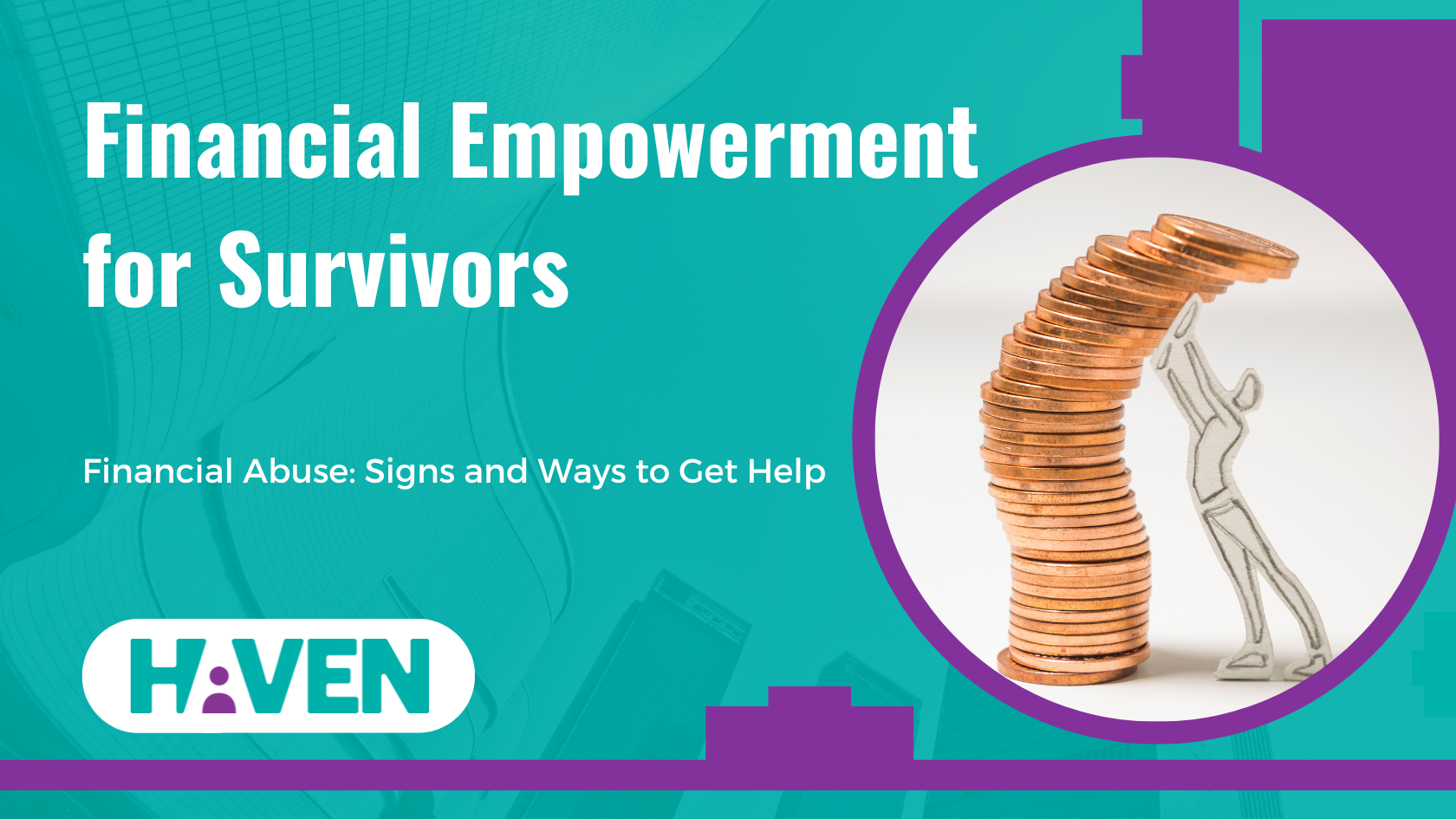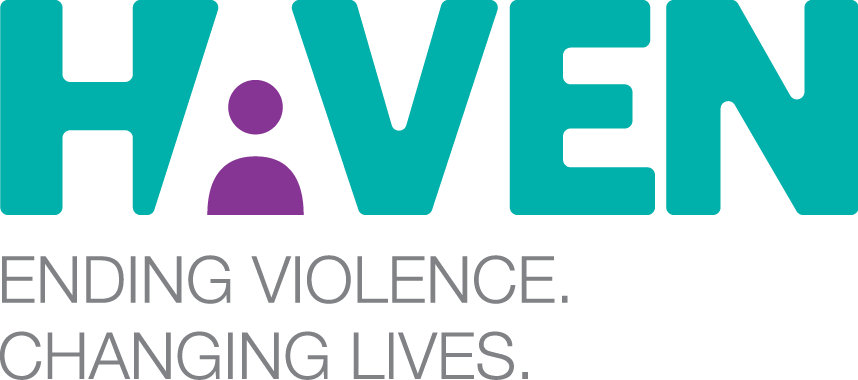
Financial Empowerment for Survivors
- hvadmin
- March 07, 2023
- financial abuse support / Uncategorized / crisis centers / abuse / Supporting Survivors / financial abuse / domestic abuse support / female survivors / domestic abuse / finance for survivors / financial abuse signs and ways to get help / finance resources
- 0 Comments
Financial Empowerment for Survivors:
Signs of Abuse and Ways to Get Help
By: Maya C and Kris G
March 2023
April is Financial Literacy Month in the United States, making this an especially relevant time to discuss the impact of economic and financial abuse on survivors of domestic abuse. Financial abuse is a tactic used by a perpetrator to control and prevent a survivor’s access to money and other financial resources, which limits their independence and increases their dependence on the abuser. Like other forms of abuse, it can take many forms and often begins subtly and progresses over time. This post is aimed at identifying signs of financial abuse, examining its impact, and giving resources on ways to get help.

Signs of Financial Abuse
The term domestic violence or domestic abuse encompasses several behaviors that an abuser may use to control and coerce a survivor. These behaviors can include any combination of physical, emotional, psychological, sexual, and financial abuse. As with all forms of abuse, financial abuse can involve both perpetrators and survivors of any background or socioeconomic status.
Of these forms of abuse, financial abuse is the most commonly experienced and the least frequently recognized tactic of domestic abuse. Financial abuse occurs in 98% of abusive situations (Adams, 2011). However, the National Coalition Against Domestic Violence (NCADV) found that 78% of Americans don’t consider financial abuse as domestic violence. Possibly because of the misconception that abuse only occurs if it involves physical harm. Additionally, a 2018 study by the Allstate Foundation found that 50% of those surveyed were unaware of any impact financial abuse would have on survivors of domestic abuse.
Here are signs of financial abuse to look out for if you think you or someone you know may be impacted by abuse (Women’s Health, 2021).
- Controlling how much money is spent:
- An abuser may constantly question purchases, demand receipts, or make you feel bad about any financial decisions you make.
- Withholding Money/Giving an Allowance:
- An abuser may act as though taking over financial decisions is a “service” to make life easier for you as if it’s a favor. The abuser may explain that giving a set amount of money will keep you or your family on track financially. However, this creates an unhealthy dynamic that keeps you reliant on your abuser.
- Withholding basic living necessities:
- In order to control you, the abuser may refuse to give money for basic necessities such as diapers for babies, medication, or even food. This sends the message that somehow you have to “earn” the right for any necessities needed for survival. This is abusive.
- Not Allowing a Partner to Work or Earn Money:
- This can look like outright telling you you can’t work. However, abusers may also stop you from working by interfering in your work such as coming to your work to embarrass you publicly, stopping you from getting to work, and even cause you to lose your job.
- Stealing a Partner’s Identity, Money, Credit, or Property:
- Abusers may steal your identity or credit cards, and file fraudulent tax returns, all to prevent you from obtaining financial means or to ruin your credit.
It’s important to note that all of the above signs/tactics are purposeful decisions made by the abuser to exert power and control their victim. This abuse is often gradual and subtle so everything the abuser does can be explained. None of this is your fault.
Some questions to ask yourself to identify financial abuse are: does your partner steal money from you or your family; make you feel as though you don’t have a right to know about finances; forbid you to work; overuse your credit cards or refuse to pay bills; or prevent you from obtaining credit cards/a bank account?

Financial Power and Control
This power and control wheel is adapted from the Canadian Center for Women’s Empowerment to demonstrate the various tactics an abuser may use to exert power and control.
- Coercion and Threats:
- Threatening to deny access to economic assets such as a phone or car; threatening to throw them out of the house/apartment/living situation; saying if they leave, they will not give any money to support them/and or their children.
- Intimidation:
- Destroying property; threatening physical violence if they do not comply/give money; refusing to pay child maintenance (such as childcare costs or child support); using money as a source of power with which to threaten (for example, taking them to court); preventing them from getting or keeping a job; making them ask for money; giving them an “allowance”; taking their money; not letting a partner know about or have access to family income.
- Emotional/Verbal Abuse:
- Making a partner feel they’re worthless by making a partner account for every cent spent; by denying basic necessities.
- Isolation:
- Withholding money so a partner is unable to do or go to the places they need or want to go; stopping a partner from going to work and seeing colleagues; not allowing partner to use the phone; destroying contact information for others/address book.
- Minimizing, Denying, Blame:
- Blaming the partner for the abuser’s actions; telling partner they’ll spend the money unless the abuser looks after it; telling partner they waste money on “silly” things; telling partner that it’s THEIR actions that make the ABUSER destroy their things, possessions, or assets.
- Using Family/Children:
- Taking children/dependent benefits, child tax credit, child savings, and birthday money; refusing to pay for diapers, milk, and clothes; destroying the children’s property; stealing children’s belongings.
- Using Privilege:
- A male partner telling a female partner men should handle all the money as head of household; exploiting existing economic disadvantages; threatening to out an LGBTQ+ partner.
This list is not intended to be an exhaustive list of all tactics of abuse. Every person encounters a different situation and has different and complicated needs to safely get out of and remain out of that situation. That is why HAVEN has a 24/7 free, confidential hotline so an advocate can support you and your specific situation. If you or someone you know is or has been impacted by domestic abuse call 603-994-SAFE for judgement-free, empowering support.

Impact of Financial Abuse
The impacts of financial abuse can be devastating. In the short term, there is limited access to using or acquiring assets such as a car; an inability to obtain safe, affordable housing; and a fear of homelessness and hardship.
Survivors of other forms of abuse and violence may experience financial burdens as well. For example, after being sexually assaulted, 50% of survivors from a 1981 study either lost or left their jobs (Ellis, 1981). The 2006 National Crime Victimization Survey found that 3 in 10 stalking victims accrue out-of-pocket costs, such as attorney fees, replacing or repairing damage to property, childcare costs, moving expenses, or changing phone numbers. According to Baum et. al., about 13% of victims incurred out-of-pocket expenses exceeding $1,000 (2009).
Long-term consequences of financial abuse may span months, years, or decades. Survivors of financial abuse lose a million days of paid work each year (National Center for Injury Prevention and Control, 2003), and healthcare costs are 42% higher for survivors of domestic abuse (McLean et al., 2018).
There are barriers to obtaining lasting safety and security for survivors due to lack of access to financial resources. Survivors may have to overcome ruined credit, find work despite a sporadic or a general lack of employment history, and/or manage legal issues due to the actions of the abuser. Women living in poverty experience domestic violence at twice the rate of those not living in poverty, which highlights the cyclical relationship between abuse and financial hardship (McClean et al, 2018). The reported leading cause of homelessness was domestic violence among unhoused women in the United States (NNEDV, 2018).

Financially Healthy Relationships
So what does a financially healthy relationship look like?
- Both partners have access to financial information and money.
- Partners set plans to meet joint goals and support one another.
- One partner may earn more income, but both partners understand and respect that decision-making is equal.
- Large or long-term financial decisions are made jointly.
- Both partners are honest and know where and how money is spent.

Financial Safety Planning
4 Steps to Create a Financial Safety Plan:
- Think about your confidence regarding finances:
-
- Reflect on your confidence level and where your ideas about finances originated
- Know that with a little work and time, gaining confidence is obtainable
- Gain information about your assets and liabilities:
-
- Consider looking for financial accounts and documents.
- Take pictures and make copies of all financial documents.
- Hide documents in a safe place.
- Begin saving money as safely as possible:
-
- Saving money can be a challenge so it often takes time and some creativity.
- Save change from cash purchases and hide it away.
- Open a separate and private bank account.
- Save any additional income, such as from bonuses or raises at work.
- Seek financial independence… One Step at a Time
-
- Consider opening up an independent checking account or applying for credit
- Seek out help if you need support or guidance
- Talk to an advocate about whether filing an order of protection would be a good step to increase your personal safety, keeping in mind that HAVEN advocates will never pressure you to make that choice if it doesn’t feel like a fit for you.
While in a relationship:
-
- If it is safe, put any extra income in a private account or hiding place and have a plan of what to do if the savings are ever discovered.
- Familiarize yourself with the location of important legal documents for you and your at-risk family members and make copies if possible.
- Keep important documents in a safe place or with a trusted friend or family member.
- Seek out confidential support from an advocate to create a safety plan to your specific circumstances.
When leaving a relationship:
- Consider taking half of joint funds, or 75% of funds if leaving with children.
- Document how these funds are removed and spent in case you need to account for them at a later date.
- Open a separate account if you have not already.
- Change all direct deposits and account PINs.
Resources and Ways to Get Help
Financial abuse is a widespread and devastating issue, but there are resources available. If you find yourself in a financially abusive situation, HAVEN advocates can help safety plan with you. Additionally, an advocate is available to provide resources on topics such as budgeting, building and repairing credit, and managing debt if requested. See below for information on reaching out to HAVEN.
- NNEDV Website – National Network to End Domestic Violence. This organization provides numerous resources and toolkits for survivors. They have financial tips and information on ending a financial relationship with an abusive partner.
- Allstate Moving Ahead Curriculum. In partnership with the NNEDV, Allstate created a curriculum with modules discussing credit, building financial foundations, and creating budgeting strategies. This curriculum is also available in Spanish/ esto también está disponible en español
- Women’s Law – Although HAVEN does not provide legal advice, this resource can be used to determine state-level laws regarding abuse and survivors’ rights.
- Federal Trade Commission – a large portion of regaining financial power is fixing your credit. The FTC is helpful by offering free credit reports, support in reporting identity theft, and consumer alerts to keep updated on financials. The website can also help find a credit counselor and counseling on the difference between debt relief and bankruptcy.
- HelpGuide – This resource offers an extensive list that covers all the bases of leaving financially abusive relationships. It includes safety planning and ways of protecting privacy. The guide is trauma-informed and dissects many common thought processes survivors may have while still in the relationship. This can help expunge the fear of the unknown that prevents many from leaving their abusive partners.
If you are no longer in immediate danger but are overwhelmed by the current state of your finances, whatever you are feeling is valid. Just remember—debt is morally neutral and what you did or did not do has led you to where you are now. HAVEN is here to support you in your journey to financial wellness, whatever that may look like for you.
HAVEN offers support, information, and access to area resources to anyone impacted by abuse and can support you if you wish to report to law enforcement. Anyone can access HAVEN advocates 24 hours a day, seven days a week, for support through our hotline 1 (603) 994-SAFE. Not comfortable using the phone? We also now have a “chat with an advocate” via our website where during our office hours, Monday-Friday, 9 AM – 4 PM, you can use an instant messaging feature to talk with an advocate at https://havennh.org/! Reach out at any time. We are here to help.
![Image Description: two hands holding a purple ribbon with text on the side. Alt text: You are not alone. HAVEN can help. Free, confidential 24-hr support 603-994-SAFE[7233]. Safety planning; in-person support at court, hospitals, and police departments; online chat support M-F 9-5 via havennh.org; shelter & housing; support groups](https://havennh.org/hs-fs/hubfs/Imported_Blog_Media/HAVENcanhelp-2.jpg?width=400&height=336&name=HAVENcanhelp-2.jpg)
References
Adams, A. E. (2011). Measuring the effects of domestic violence on women’s financial well-being. Center for Financial Security, University of Wisconsin-Madison. Issue Brief, 5, 1-6.
Baum, K., Catalano, S., & Rand, M. (2009). Stalking victimization in the United States. U.S. Department of Justice, Office of Justice Programs. Retrieved from https://www.victimsofcrime.org/docs/src/baum-k-catalano-s-rand-m-rose-k-2009.pdf?sfvrsn=0
Canadian Center for Women’s Empowerment. (2022, July 14). Economic abuse power control wheel. CCFWE. Retrieved from https://ccfwe.org/economic-abuse-power-control-wheel/
Ellis, E. M., Atkeson, B. M., & Calhoun, K. S. (1981). An assessment of long-term reaction to rape. Journal of Abnormal Psychology, 90(3), 263.
McLean, G., & Bocinski, S. G. (2020, October 30). The economic cost of intimate partner violence, sexual assault, and stalking. Institute for Women’s Policy Research. Retrieved from https://iwpr.org/iwpr-general/the-economic-cost-of-intimate-partner-violence-sexual-assault-and-stalking/#_edn13
National Center for Injury Prevention and Control. (2003, March). Costs of intimate partner violence against women in the United States. Centers for Disease Control and Prevention. Retrieved from https://www.cdc.gov/violenceprevention/pdf/ipvbook-a.pdf
National Network to End Domestic Violence. (2018). Domestic violence, housing, and homelessness. NNEDV. Retrieved from https://nnedv.org/wp-content/uploads/2019/07/Library_TH_2018_DV_Housing_Homelessness.pdf
Pennsylvania Coalition Against Domestic Violence. (2023, February 27). Financial abuse. PCADV. Retrieved from https://www.pcadv.org/financial-abuse/?utm_source=twitter&utm_medium=social&utm_campaign=PayEquity&utm_id=FinancialLiteracy
Salamone, N. (2010). Domestic violence and financial dependency. Forbes
Sharp, N. (2008). ‘What’s yours is mine’ the different forms of economic abuse and its impact on women and children experiencing domestic violence. Refuge
United States Department of Justice. (2009, January 16). National Crime Victimization Survey: Stalking Victimization Supplement. Retrieved from https://doi.org/10.3886/ICPSR20080.v1.
Women’s Health. (2021, February 15). Financial abuse. Office on Women’s Health. Retrieved from https://www.womenshealth.gov/relationships-and-safety/other-types/financial-abuse
You Might Also Like

Recreation and Self Care for Survivors



